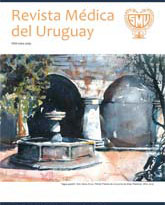Encuesta Nacional de Comportamientos Disruptivos en el Equipo de Salud
Identificación del problema y diagnóstico situacional
Resumen
El comportamiento disruptivo (CD) en el equipo de salud pone en riesgo la seguridad del paciente y la seguridad del equipo sanitario. Es responsabilidad del sistema sanitario y de los profesionales diagnosticar y gestionar esta situación que impacta negativamente para trabajar en equipo, la salud del personal y los resultados asistenciales.
Objetivo: realizar la primera encuesta nacional de CD en el equipo de salud. Establecer la prevalencia, sus desencadenantes y consecuencias.
Material y método: el Ministerio de Salud Pública (MSP), mediante la Estrategia Nacional de Seguridad del Paciente, convocó en forma voluntaria a todos los prestadores sanitarios (públicos y privados) a participar de la encuesta con el fin de desarrollar una política pública. La encuesta fue anónima y voluntaria. Demandó un período de cuatro meses (junio de 2013 a setiembre de 2013). Incluyó distribución, realización y devolución.
Resultados: participaron 38 prestadores; 4.782 encuestas fueron respondidas por 1.713 (36%) auxiliares de enfermería, 1.040 (22%) médicos y 662 (14%) licenciados de enfermería. El 80% trabaja más de 30 horas semanales. Presenciaron CD 88,5% (4.231) y 60% (2.815) lo sufrieron. Predominó el comentario despectivo sobre colegas (75%) y en gritos agresivos y arrebatos de ira (45%). Es frecuente en un 20% por lo menos una vez por semana. El 71% piensa que los desencadenantes están en el ambiente laboral, predominando la carga de trabajo (47,5%) sobre la remuneración (33%). El 63% identifica problemas personales; 53% identifica estas conductas en sus pares; 20% los pone en riesgo de cometer errores; 42% pensó en cambiar de trabajo, y 6% cambió.
Discusión y conclusiones: primera encuesta nacional sobre CD a nivel mundial, única impulsada desde la rectoría sanitaria. El problema es de alta incidencia, disminuye la seguridad y deteriora la transferencia de información y capacidad de trabajar en equipo. Existe una baja percepción del riesgo. La remuneración económica no es el principal desencadenante identificado y el CD surge mayormente entre pares. Impacta sobre la retención de los recursos humanos así como en la seguridad laboral.
Citas
(2) Hollowell EE. The disruptive physician: handle with care. Trustee 1978; 31(6):11-3,15,17.
(3) Leape LL, Shore MF, Dienstag JL, Mayer RJ, Edgman-Levitan S, et al. Perspective: a culture of respect, part 1: the nature and causes of disrespectful behavior by physicians. Acad Med 2012; 87(7):845-52.
(4) Samenow CP, Spickard A Jr, Swiggart W, Regan J, Barrett D. Consequence of physician disruptive behavior. Tenn Med 2007; 100(11): 38-40.
(5) Sataloff RT. Disruptive physicians: sound more familiar than you thought? Ear Nose Throat J 2008; 87(3):124-7.
(6) Rosenstein AH, O’Daniel M. A survey of the impact of disruptive behaviors and communication defects on patient safety. Jt Comm J Qual Patient Saf 2008; 34(8):464-71.
(7) Roback HB, Strassberg D, Iannelli RJ, Finlayson AJ, Blanco M, Neufeld R. Problematic physicians: a comparison of personality profiles by offence type. Can J Psychiatry 2007; 52(5):315-22.
(8) Leape LL, Fromson JA. Problem doctors: is there a system-level solution? Ann Intern Med 2006; 144(2):107-15.
(9) Krebs EE, Garrett JM, Konrad TR. The difficult doctor? Characteristics of physicians who report frustration with patients: an analysis of survey data. BMC Health Serv Res 2006; 6:128.
(10) Rosenstein AH, O’Daniel M. Disruptive behavior and clinical outcomes: perceptions of nurses and physicians. Am J Nurs 2005; 105(1):54-64.
(11) Rosenstein AH, O’Daniel M. Invited article: Managing disruptive physician behavior: impact on staff relationships and patient care. Neurology 2008; 70(17):1564-70.
(12) Castledine SG. Dealing with difficult doctors. Br J Nurs 2008; 17(20):1305.
(13) Sandlin-Leming D. Dealing with intimidating and disruptive behaviors in the health care setting. J Perianesth Nurs 2008; 23(6):434-6.
(14) Castronuovo JJ Jr, Cossman DV, Goldberg LP, Gordon LA, et al. When good doctors go bad: a Leape of faith. Ann Surg 2008; 247(6):1076-7.
(15) Rosenstein AH, O’Daniel M. Impact and implications of disruptive behavior in the perioperative arena. J Am Coll Surg 2006; 203(1):96-105.
(16) Samenow CP, Swiggart W, Spickard A Jr. A CME course aimed at addressing disruptive physician behavior. Physician Exec 2008; 34(1):32-40.
(17) Leape LL, Shore MF, Dienstag JL, Mayer RJ, Edgman-Levitan S, et al. Perspective: a culture of respect, part 1: the nature and causes of disrespectful behavior by physicians. Acad Med 2012; 87(7):845-52.
(18) Lazoritz S. Coaching for insight: a tool for dealing with disruptive physician behavior. Physician Exec 2008; 34(1):28-31.
(19) Hickson GB, Pichert JW, Webb LE, Gabbe SG. A complementary approach to promoting professionalism: identifying, measuring, and addressing unprofessional behaviors. Acad Med 2007; 82(11):1040-8
(20) Committee on Patient Safety and Quality Improvement of American College of Obstetricians and Gynecologists. ACOG Committee Opinion. Number 366 May 2007. Disruptive behavior. Obstet Gynecol 2007; 109(5):1261-2.
(21) Simpson KR. Disruptive clinician behavior. MCN Am J Matern Child Nurs 2007; 32(1):64.
(22) Keogh T, Martin W. Managing unmanageable physicians: leadership, stewardship and disruptive behavior. Physician Exec 2004; 30(5):18-22.
(23) Youssi MD. JCAHO standards help address disruptive behavior. Physician Exec 2002; (28)3:12-3.
(24) Rosenstein AH, Naylor B. Incidence and impact of physician and nurse disruptive behaviors in the emergency department. J Emerg Med 2012; 43(1):139-48.
(25) Lucian Leape Institute at the National Patient Safety Foundation. Through the Eyes of the Workforce: Creating Joy, Meaning, and Safer Health Care. Obtenido de: http://www.surveymonkey.com/s/LLI_WorkforceSafety Consulta: 5 de abril de 2014.
(26) Pitkanen M, Hurn J, Kopelman MD. Doctors’ health and fitness to practise: performance problems in doctors and cognitive impairments. Occup Med (Lond) 2008; 58(5):328-33.
(27) Crausman RS, Savoretti A, Conroy J. Disruptive physician behaviors. Med Health R I 2007; 90(2):48-9.
(28) Bauman RR. Disruptive physicians...and how to deal with them. J Med Pract Manage 2006; 22(2):79-83.
(29) Porto G, Lauve R. Disruptive clinician behavior: a persistent threat to patient safety. Patient Safety Qual Healthc 2006; 3:16-24
(30) Lehmann C. Disruptive physicians get makeover in hospital therapy program. Psychiatric News 2003; 38(12):12.
(31) Papadakis MA, Teherani A, Banach MA, et al. Disciplinary action by medical boards and prior behavior in medical school. N Engl J Med 2005; 353(25):2673-82.














